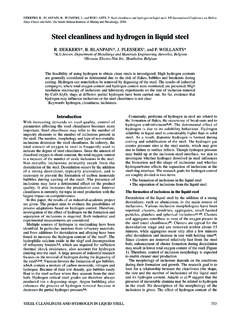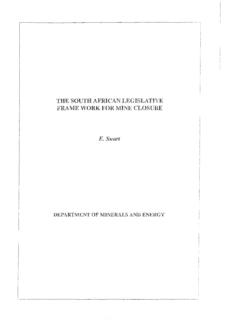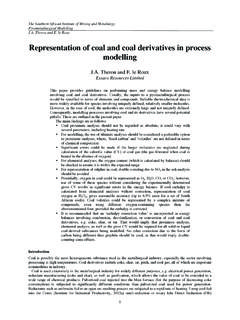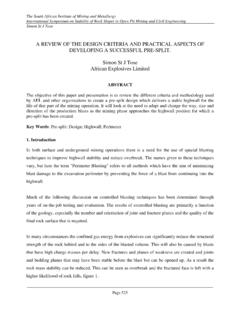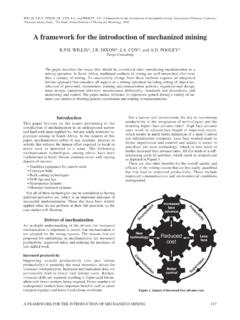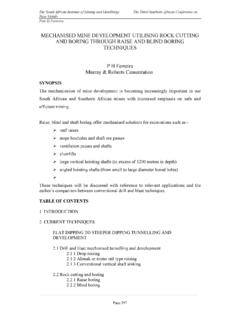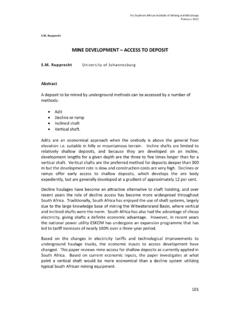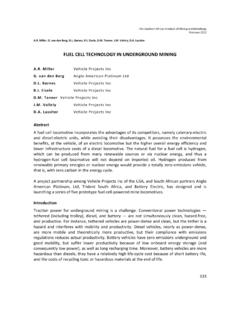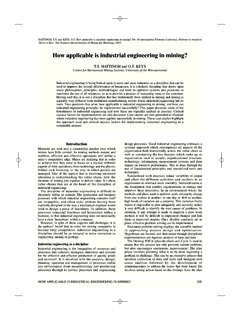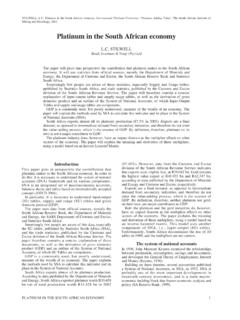Transcription of THE CHALLENGES OF INFRASTRUCTURE DEVELOPMENT …
1 The Southern African Institute of Mining and Metallurgy Narrow Vein and Reef 2008 G L Smith and F A C da Lomba. _____ Page 1 THE CHALLENGES OF INFRASTRUCTURE DEVELOPMENT IN THE EASTERN LIMB OF THE BUSHVELD COMPLEX OF SOUTH AFRICA SMITH Pr Eng and DA LOMBA Anglo Platinum Limited Synopsis As the Platinum mining industry expands in the Eastern Limb of the Bushveld Complex it is increasingly evident that a major constraint to DEVELOPMENT is a lack of appropriate INFRASTRUCTURE . Of critical concern are water resources and spatial DEVELOPMENT / INFRASTRUCTURE .
2 This paper identifies the context for INFRASTRUCTURE DEVELOPMENT in the Eastern Limb and two solutions that have evolved in the areas of water supply and spatial DEVELOPMENT . INTRODUCTION In an economics context, INFRASTRUCTURE is considered to be the structural elements of an economy which allow for the production of goods and services, without themselves being part of the production process. Despite the lack of a specific definition, INFRASTRUCTURE has largely become understood as to comprise road and rail transport systems, public transport systems, airports, public educational facilities, water supply and water resources, wastewater management, solid waste treatment and disposal, electric power generation and transmission, telecommunications and hazardous waste management systems.
3 Critically it is important to understand that INFRASTRUCTURE not only comprises these physical elements but also the operating procedures, management practices and developmental policies that facilitate the effective utilization and DEVELOPMENT of the INFRASTRUCTURE in response to societal demand. Conceptually, the nature (concentration, quality and efficacy) of INFRASTRUCTURE will therefore vary from national level through provinces, and regions ultimately to municipalities, subject to a range of political and economic legacies.
4 Within this context South Africa suffers from a disparate distribution of INFRASTRUCTURE ranging from established and maintained urban and industrial areas such as Gauteng through to the CHALLENGES prevailing in the Eastern Cape. INFRASTRUCTURE plays and important role in the social and economic DEVELOPMENT of communities. Areas without access to effective INFRASTRUCTURE are inevitably characterized by high levels of poverty with municipalities tending to focus on two key INFRASTRUCTURE delivery issues; the provision of access to basic municipal services (water, sanitation, electricity and solid waste removal) and the provision and maintenance of general The Southern African Institute of Mining and Metallurgy Narrow Vein and Reef 2008 G L Smith and F A C da Lomba.
5 _____ Page 2 INFRASTRUCTURE and services within the municipal area. This approach typically manifests itself in a prioritized programme covering: Provision of free basic services; Access to municipal services in previously disadvantaged areas; Water services (provision and maintenance); Solid waste removal; Electricity provisioning; Transport; Roads; and Storm water management. THE EASTERN LIMB OF THE BUSHVELD COMPLEX The Eastern Limb of the Bushveld Complex, centered on the town of Steelpoort, and extending in an arc to Fetakgomo in the northwest and Groblersdall in the southwest, is an area that has suffered from a legacy of limited infrastructural DEVELOPMENT .
6 Further DEVELOPMENT of INFRASTRUCTURE in this area is complicated by the fact that the platinum producing areas of the Eastern Limb span two provinces; Limpopo and Mpumalanga, and is administered by the Sekhukhune Cross Boundary District Municipality ( CBDM ). The Sekhukhune CBDM covers the following areas: Northern District Council Bosveld District Council Hlogotlou/Lepelle Eastern Tubatse Dilokong Tubatse/Steelpoort Ngwaritsi/Makhuduthamaga Nebo North Nokotlou/Fetakgomo Highveld District Council Lowveld Escarpment District Council Groblersdal Marble Hall Moutse Steelpoort/Ohrigstad/ Burgersfort Each Province develops and implements a Provincial Growth and DEVELOPMENT Strategy ( PGDS ) which is a framework to guide growth and DEVELOPMENT over a 10 year period.
7 The PGDS is underpinned, Nationally, by a range of initiatives such as The National Spatial DEVELOPMENT Plan, The Reconstruction and DEVELOPMENT Plan and the Accelerated and Shared Growth Initiative for South Africa ( AsgiSA ). A Provincial Growth and DEVELOPMENT Strategy is thus an expression of a National policy framework at Provincial The Southern African Institute of Mining and Metallurgy Narrow Vein and Reef 2008 G L Smith and F A C da Lomba. _____ Page 3 level to provide a clear vision for growth and DEVELOPMENT and to set the pace, and tone, for growth and infrastructural DEVELOPMENT for the Province.
8 The enduring INFRASTRUCTURE legacy of pre 1994 Nationalist policies is institutional fragmentation, backlogs in basic services delivery, a lack of centralized local government in rural areas and marginalized provincial economies. In the eastern limb this institutional fragmentation was exacerbated as the area was divided into the homelands of Lebowa, Gazankulu, Venda and Kwa-Ndebele within an area administered by the Transvaal Provincial Administration. This situation concealed many capacity constraints paving the way for corruption and inefficient service delivery.
9 Rectifying this legacy is a major, ongoing challenge which is still compounded by a lack of reliable data on backlogs and sustainable industry DEVELOPMENT options. The demographics of the Sekhukhune Cross Boundary District Municipality and interalia the Eastern Limb can be broadly characterized by: a young population; a high percentage of women; a largely unskilled / semi-skilled component of the economically active sector; a high unemployment rate; and despite economic growth since 1994, a high dependency ratio (~19 unemployed to one employed).
10 Essentially the majority of the people are unemployed, unskilled or semi-skilled and living in poverty. This poses significant socio-economic CHALLENGES in the sustainable provision of services and DEVELOPMENT of INFRASTRUCTURE . In addressing these CHALLENGES the Provincial Governments have identified and implemented a number of DEVELOPMENT clusters, one of which is the Platinum Mining cluster on the Dikolong corridor between Polokwane and Burgersfort. DEVELOPMENT clusters create critical mass, spatial concentration, lead to competitive advantage and promote a self reinforcing cycle of growth.
